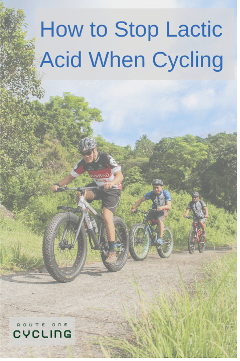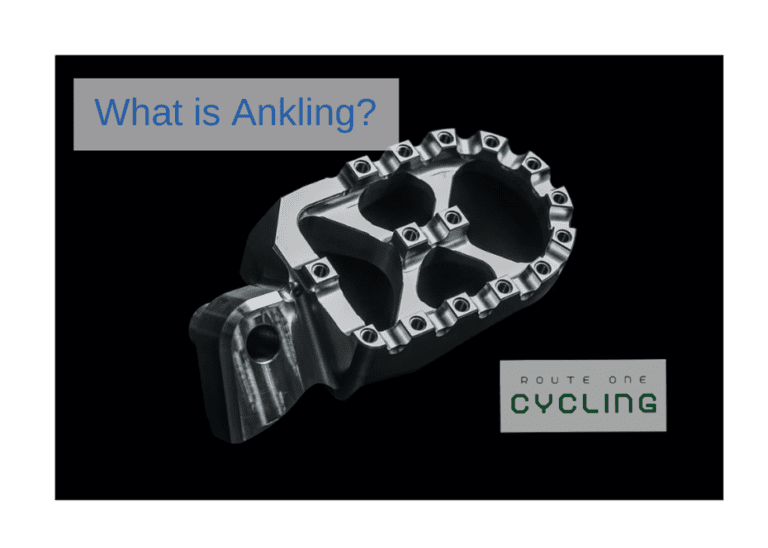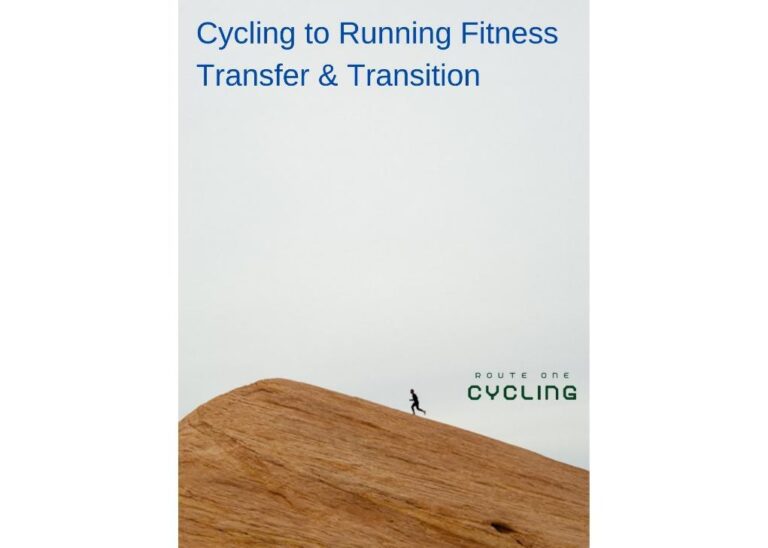Everything You Need to Know About Cycling and Lactic Acid
I was on a ride the other day with a group and someone began talking to me about ride speed and how to stop lactic acid when cycling. I was a bit confused when the conversation of lactic acid began.
The majority of the riders in the group were still well within their aerobic threshold. However, for this rider, he was beginning to feel cramps and tightening in his legs.
When I ran the 400 meter dash years ago, I was blessed to have a grandfather who was both a cyclist and a track coach who sent many folks into the Pac 12 for running out of Southern California.
I found myself running some fairly impressive times and I am happy to share what knowledge has carried over from my lactic acid training that I did from running, and what I do now for cycling.
This is helpful to learn how to stop lactic acid when cycling.
Note: Lactic acid training is intense, and can be taxing on the body in the long run. It also is unlike aerobic workouts in that these anaerobic workouts have an intense level of impact on the body. If your legs are sore for the next day, here are some great ways to alleviate the pain.
In this post we will discuss lactic acid buildup. We will discuss how to slow down the process of lactic acid buildup while cycling, and we will discuss how to remove lactic acid from the legs when cycling. Be sure not to cycle too much and avoid burnout.
If you are not doing the things you need to do before, during and after a ride, your legs will burn no matter what training you do. Read this guide here to get the most out of your body during a ride.
We will also go over 4 separate workouts to train your body to be better at enduring lactic acid buildup. Most importantly, we will discuss the difference between aerobic and anaerobic buildup.
In many cases, you may simply need to train your heart and increase your body’s aerobic capacity to eliminate the need for lactic acid while endurance cycling. What this means in short is: Ride longer distances at a slower pace. Your distance times will drop dramatically.
How to Stop Lactic Acid When Cycling?
There are two ways to stop lactic acid when cycling. The first is to increase your aerobic endurance.
Many think that because others are faster than them, it just means that they are better at controlling the burn for longer periods of time. This could not be further from the case.
If your aerobic capacity is trained, this will then increase the speed substantially to where you do not need to even activate the lactic acid response. Yes, this means that there are cyclists averaging 12 mph up a 5% grade are not dealing with lactic acid buildup.
They are in pain, but they are not dealing with tightness in the muscles or cramps. The way to do this is by doing base rides. Increase your mileage and decrease your speed of riding – by a lot.
Decrease the rate to where you are in zone 1 and zone 2 of your aerobic system. After riding in this space for years you will see your times drop, while still feeling great after the ride.
It’s an amazing feeling.
The second is to increase your lactic capacity. I write this with caution because I wasted many years training my lactic capacity before my distance times dropped substantially simply by training my aerobic capacity.
If your goal is to be a distance cyclist and you feel you are at a point where you feel the only way to increase speed is to increase lactic capacity (e.g. you can ride 50-60 miles ride averaging 15 miles per hour moving speed competently) then you should think about bicycle speed and increasing your lactic capacity for times when you would like an extra boost in riding.
How to Train Lactic Acid Capacity in Cycling?
I am taking these exercises from college and high school. Keep in mind that the high school and college body is far more malleable than a mid-30’s body.
I still do many of these practices (mainly because they’re fun), though not nearly as often as I simply train my aerobic threshold to stop the lactic acid response from needing to occur.
Of course, I also don’t race often so I don’t typically find myself in positions where I need to do an all out sprint to complete a race.
However, if you are on a 50 mile ride and you are feeling lactic acid buildup while riding with your peers, consider training your aerobic system before training your anaerobic system (the system that works with lactic acid).


On-Bike Lactic Acid Capacity Training
Here are some of my practices for Lactic Acid training that I’ll do to get a bit quicker on my pedals. If you do not do an adequate warm up complete with dynamic stretching, and a warmup ride, you will cramp and it will hurt.
The recoveries are long, and if you are used to distance and endurance training it will feel very alien. Take the full recovery, because you will still fatigue and slow down.
- Hill Repeats: This is a great 2 for 1 because you are also increasing your hill climbing ability (A different skillset and muscle group from your flat riding muscle group).
- Find a hill with about a 3-4% grade. The ride up the hill should last for 2-3 minutes. Those 2-3 minutes should be as fast as you can maintain for 2-3 minutes.
- Once you reach that distance, you now have your indicator of how far you will go.
- Do a full recovery (10-15 minutes) and repeat 2 more times going that same distance of the first repeat.
- Flat repeats: These are great to increase your lactic buildup for end of race or middle race pushes.
- Find a straightaway that ideally is not affected by wind. The stretch should be about 2 miles long if you are on a road bike.
- Ride at your max speed for 2 minutes. If you able to ask yourself what pace should you be going while you are riding, then you are moving too slowly.
- Once you have the distance marked from the 1st set, do 2 more at the same distance. Do a full recovery in between each (8 minutes).
Off-Bike Lactic Acid Capacity Training
These are also useful, although if you are prone to overuse injuries, it may make more sense to train on the bike.
Training Lactic Acid is already difficult on the body, and running can create a lot of impact. Training lactic acid through running transfers to cycling.
Once again, a warmup with dynamic stretches is necessary or you will have a substantial fall off on the second repeat.
- 300 meter repeats: Find a track and return to your glory days. A 300 meter is 3 quarters of the way around a track.
- Run a 300 meter at 80% pace.
- Take full recovery for these (8-10). Everyone’s timing will be vastly different, so it is difficult to set a goal.
- A very quick person who has some level of lactic acid endurance will be around 36-40. A person who is just beginning though has done other athletic activities will be around 45-50 seconds for their first. A person who is generally sedentary will be around 60 seconds and higher.
- 200 repeats: A 200 meter is half of the track.
- Run a 200 meter full out. Do this 4 times with full recovery.
- The recovery should be 8-10 minutes in between.
- If you able to think or wonder if you are going fast enough, then you are not moving fast enough to activate the lactic acid response.
How do you drain lactic acid from legs cycling?
The easiest way to drain lactic acid from legs after cycling is to follow this process. To drain lactic acid from legs in cycling, you need to do an active cooldown. Ride for 30-45 minutes in zone 1 recovery.
Then following, stretch the hamstrings either dynamically or static. Finally, eat 1-2 bananas, lean your legs against a wall and sit with your back on the ground for 15 minutes.
Go to the restroom and continue with your day. Drink lots of water to replenish fluids so that you can sleep well in the evening.
How do I reduce lactic acid when cycling?
The easiest way to reduce lactic acid when cycling is to eliminate the need for lactic acid at all.
This means increasing your aerobic capacity so that at higher speeds for more lengths of time, you can ride without feeling fatigue and activating the lactic acid response. Your other option is to do repeats to simulate a lactic acid response as listed above.
Though as you can see, this is only for when a cyclist truly feels they have reached the max of their aerobic capacity potential and are truly looking to develop their sprint muscles for gut races.
Why are my legs extremely sore after spin?
Your legs are sore for several reasons. Mild soreness after spin is normal, though excessive soreness can be for several reasons:
- Try a sufficient warmup: Try riding longer during your warm up and slower. Ride long enough at a slow distance on low resistance until your body begins to sweat. This is your aerobic system turning on and activating.
- Try a sufficient cooldown: Try riding for 30-45 minutes after your ride at a zone 1 cooldown pace. Then afterwards, stretch, ice and massage. This will allow the body to signal that the workout is done, and the muscles are able to relax. If the muscles relax, they will not become sore.
- Has your lactic acid capacity has been reached? Try increasing your aerobic capacity or increasing your lactic acid capacity. For more on this, read above.
- What about your Water intake? This is very simple, though many athletes forget. Your body needs water to function. If you are doing all three of the above correctly, then typically your body is not receiving enough water.
Conclusion
How to stop Lactic Acid When Cycling? Lactic acid can be painful. Anyone that chooses to ride distances where they are specifically training their lactic acid development can make a fairly safe bet that they will be dealing with a lot of pain.
What is most important to understand with lactic acid is that for the most part, you simply can ignore the pain and push through it.
However, if you can not, it may be time to increase your tolerance by doing the workouts above, or by eliminating the need for lactic acid by increasing your aerobic capacity.



![Why are cyclists so skinny? [The lifestyle took me from 215lbs to 180lbs]](https://routeonecycling.com/wp-content/uploads/2023/04/Why-are-cyclists-so-skinny.png)



